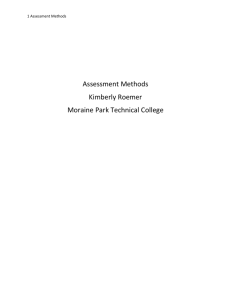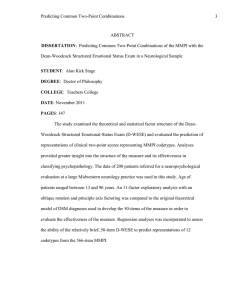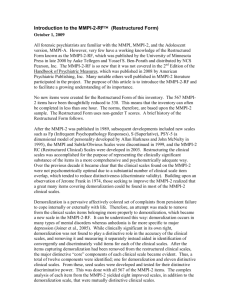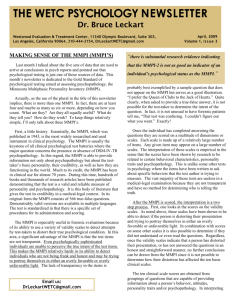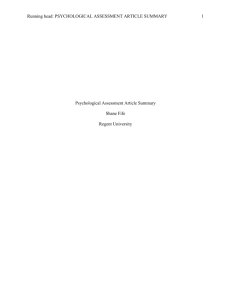Assessment Tools in Counseling
advertisement
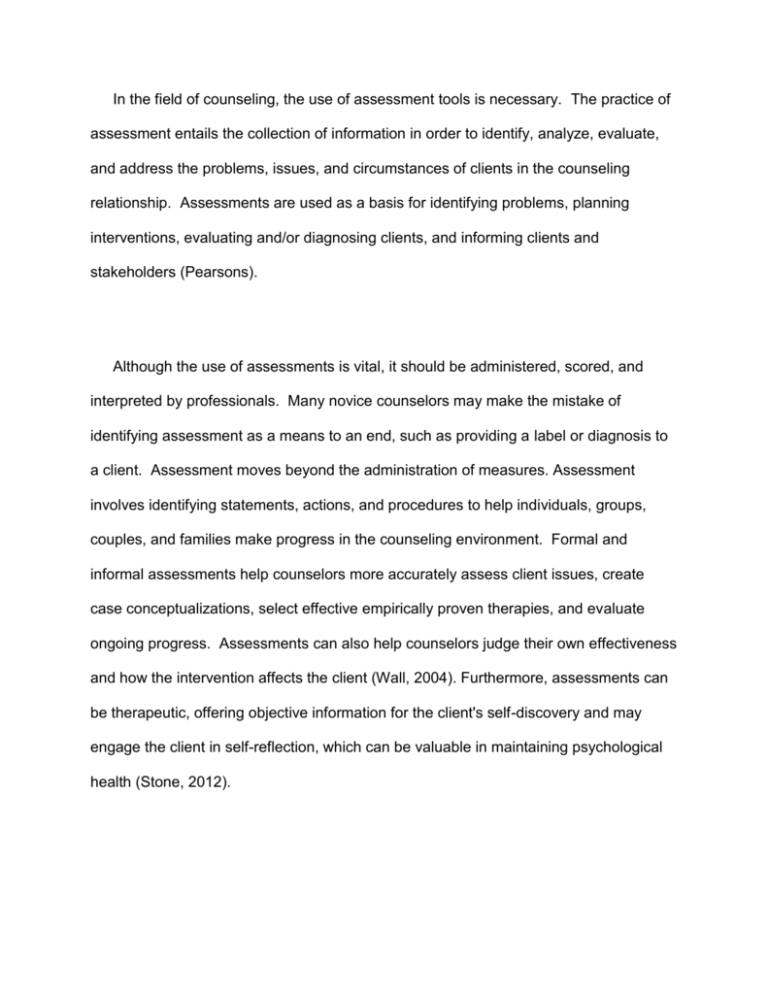
In the field of counseling, the use of assessment tools is necessary. The practice of assessment entails the collection of information in order to identify, analyze, evaluate, and address the problems, issues, and circumstances of clients in the counseling relationship. Assessments are used as a basis for identifying problems, planning interventions, evaluating and/or diagnosing clients, and informing clients and stakeholders (Pearsons). Although the use of assessments is vital, it should be administered, scored, and interpreted by professionals. Many novice counselors may make the mistake of identifying assessment as a means to an end, such as providing a label or diagnosis to a client. Assessment moves beyond the administration of measures. Assessment involves identifying statements, actions, and procedures to help individuals, groups, couples, and families make progress in the counseling environment. Formal and informal assessments help counselors more accurately assess client issues, create case conceptualizations, select effective empirically proven therapies, and evaluate ongoing progress. Assessments can also help counselors judge their own effectiveness and how the intervention affects the client (Wall, 2004). Furthermore, assessments can be therapeutic, offering objective information for the client's self-discovery and may engage the client in self-reflection, which can be valuable in maintaining psychological health (Stone, 2012). There are many different assessment tools that are used by professionals all over the world, and have been around for a number of years. A very well-known assessment tool is the Minnesota Multiphasic Personality Inventory. The Minnesota Multiphasic Personality Inventory (MMPI) was developed in the late 1930's by psychologist Starke R. Hathaway and psychiatrist J.C. McKinley at the University of Minnesota. Today, it is used mostly by mental health professionals as a clinical testing instrument, and is one of the most researched psychological tests in existence (Cherry). The MMPI has also been utilized in custody disputes numerous times in the past. It has often been used to prove whether a criminal is really mentally unstable, or just lying to avoid a death sentence. Employers who run businesses which subject their employees to high levels of stress also sometimes use the instrument to determine whether or not applicants are capable of coping with the position’s demands (Freberg, 2014). Since the creation of MMPI, a new form of the test has been made; the MMPI2. The MMPI-2 is designed with 10 clinical scales which assess 10 major categories of abnormal human behavior, and four validity scales, which assess the person’s general test-taking attitude and whether they answered the items on the test in a truthful and accurate manner. The MMPI-2 is made up 10 clinical subscales, which are a result of answering certain questions on the test in a specific manner. These subscales are: Hypochondriasis (Hs) – The Hypochondriasis scale tapes a wide variety of vague and nonspecific complaints about bodily functioning. These complaints tend to focus on the abdomen and back, and they persist in the face of negative medical tests. There are two primary factors that this subscale measures — poor physical health and gastrointestinal difficulties. The scale contains 32 items. Depression (D) – The Depression scale measures clinical depression, which is characterized by poor morale, lack of hope in the future, and a general dissatisfaction with one’s life. The scale contains 57 items. Hysteria (Hy) – The Hysteria scale primarily measures five components — poor physical health, shyness, cynicism, headaches and neuroticism. The subscale contains 60 items. Psychopathic Deviate (Pd) – The Psychopathic Deviate scale measures general social maladjustment and the absence of strongly pleasant experiences. The items on this scale tap into complaints about family and authority figures in general, selfalienation, social alienation and boredom. The scale contains 50 items. Masculinity/Femininity (Mf) – The Masculinity/Femininity scale measures interests in vocations and hobbies, aesthetic preferences, activity-passivity and personal sensitivity. It measures in a general sense how rigidly a person conforms to very stereotypical masculine or feminine roles. The scale contains 56 items. Paranoia (Pa) – The Paranoia scale primarily measures interpersonal sensitivity, moral self-righteousness and suspiciousness. Some of the items used to score this scale are clearly psychotic in that they acknowledge the existence of paranoid and delusional thoughts. This scale has 40 items. Psychasthenia (Pt) -The Psychasthenia scale is intended to measure a person’s inability to resist specific actions or thoughts, regardless of their maladaptive nature. “Psychasthenia” is an old term used to describe what we now call obsessivecompulsive disorder (OCD), or having obsessive-compulsive thoughts and behaviors. This scale also taps into abnormal fears, self-criticisms, difficulties in concentration and guilt feelings. This scale contains 48 items. Schizophrenia (Sc) – The Schizophrenia scale measures bizarre thoughts, peculiar perceptions, social alienation, poor familial relationships, difficulties in concentration and impulse control, lack of deep interests, disturbing question of self-worth and selfidentity, and sexual difficulties. This scale has 78 items, more than any other scale on the test. Hypomania (Ma) – The Hypomania scale is intended to measure milder degrees of excitement, characterized by an elated but unstable mood, psychomotor excitement (e.g., shaky hands) and flight of ideas (e.g., an unstoppable string of ideas). The scale taps into overactivity — both behaviorally and cognitively — grandiosity, irritability and egocentricity. This scale contains 46 items. Social Introversion (Si) – The Social Introversion scale measures the social introversion and extroversion of a person. A person who is a social introvert is uncomfortable in social interactions and typically withdraws from such interactions whenever possible. They may have limited social skills, or simply prefer to be alone or with a small group of friends. This scale has 69 items (Framingham, 2013). Assessment tools, such as the MMPI are powerful psychology instruments used for determining and assessing mental illnesses. The MMPI has undergone several revisions in the past, and is now one of the most reliable mental assessment tools to date (Freberg, 2014). As a substance abuse counselor, it will be vital to know about the various assessment tools, and how to properly use them in assessing clients. Andrea Schneider Reference Page: Cherry, K. (n.d.). Retrieved from http://psychology.about.com/od/psychologicaltesting/a/mmpi.htm Framingham, J. (2013). Minnesota multiphasic personality inventory (mmpi). Retrieved from http://psychcentral.com/lib/minnesota-multiphasic-personalityinventory-mmpi/0005959 Freberg, L. (2014). An introduction to the minnesota multiphasic personality inventory psychology test. Retrieved from http://psych.answers.com/socialpsychology/an-introduction-to-the-minnesota-multiphasic-personality-inventorypsychology-test Pearsons. Retrieved from http://www.pearsonhighered.com/assets/hip/us/hip_us_pearsonhighered/samplecha pter/0137017510.pdf Stone, D. (2012, September 14). Assessment in counseling. Retrieved from http://psychological-musings.blogspot.com/2012/09/assessment-in-counseling.html Learning Plan 1: Scoring Guide 1 Report on Assessment Methods Scoring Standards: 10/5 = Excellent quality; criteria is fully demonstrated; no errors are evident; all key concepts of theory are addressed 8/4 = Acceptable quality; minor flaws or errors exist or are omitted; Information is correct 4/2 = Criterion attempted but needs improvement; response shows minimal understanding of concepts; details and support are lacking 0 = Criterion is unacceptable or not complete - response is incorrect, irrelevant or missing. 10 = Criterion is met 0 = Criterion is not met 5 = Criterion is met 0 = Criterion not met Criteria Values Report describes the purpose of clinical assessment. 10 8 4 0 Report describes the methods of clinical assessment. 10 8 4 0 Report explains one method of clinical assessment. (i.e. clinical interviewing, MMPI, TAT, WAIS-III, etc.) 10 8 4 0 Report describes the historical development of the clinical assessment method/tool chosen. 10 8 4 0 Report analyzes the method of clinical assessment that she/he has chosen. 10 8 4 0 Report analyzes the relevance of the clinical assessment method chosen to a client with a dual disorder. 10 8 4 0 10 0 Report is completed according to prescribed deadlines. Learner distinguishes between fact and opinion. 5 4 2 0 Learner synthesizes information from a variety of sources. 5 4 2 0 Learner uses bias free language. 5 4 2 0 Learner applies standard rules of language structure including grammar, spelling and punctuation. 5 4 2 0 Learner is consistent with established criteria. 5 4 2 0 Learner organizes information. 5 4 2 0 5 0 Learner produces evidence of learning.
